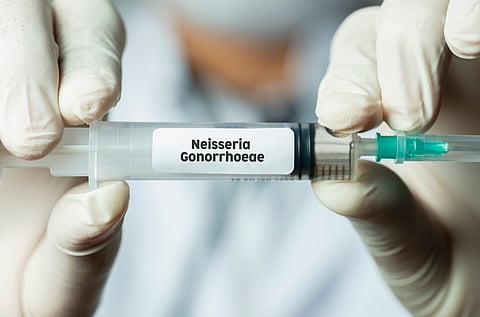

A new antibiotic pill has shown promise in treating the sexually transmitted infection gonorrhoea, including forms of the infection that no longer respond to existing drugs. The results offer hope at a time when health officials warn that gonorrhoea may soon become much harder to treat.
The new drug, called gepotidacin, was tested in a major international study published in the journal The Lancet on April 14, 2025. The drug is already used to treat urinary tract infections. This is the first new gonorrhoea treatment in decades that’s shown strong results.
The researchers found that the pill worked just as well as the current standard treatment, which involves two different types of antibiotics — an injection of ceftriaxone and an oral dose of azithromycin.
Oral gepotidacin could be a good option for people who can’t take injections, those who are allergic to drugs like ceftriaxone and in cases where the standard treatment doesn’t work. The drug works by blocking the bacteria’s ability to replicate its DNA, a novel mechanism that differs from other antibiotics.
Gonorrhoea, also known as “the clap”, is passed on through unprotected vaginal, oral or anal sex, and can spread through vaginal fluid or semen. It can also be passed from mother to baby during childbirth. The infection is caused by a bacterium called Neisseria gonorrhoeae and is usually treated with antibiotics.
While men often show symptoms like discharge, many women don’t have symptoms, which makes it harder to detect and treat, explained an article in The Lancet. If left untreated, gonorrhoea can lead to serious health problems, especially for women — including infertility and pelvic pain — and can increase the risk of HIV.
The trial included 628 people with uncomplicated gonorrhoea. While half the participants took two doses of oral gepotidacin, the others received a single injection of ceftriaxone and one oral dose of azithromycin. Researchers checked if the infection was gone 4-8 days later.
And the results were promising — gepotidacin worked just as well as the current treatment. Around 93 per cent of those who took it were cured, compared to 91 per cent of those who received the usual treatment.
The pill was particularly effective in clearing rectal infections, working in 100 per cent of cases. It was less effective for throat infections, curing 78 per cent of cases compared to 94 per cent with the current treatment. Researchers said more data is needed, especially for throat infections and in more diverse groups of people. The drug caused some mild side effects such as nausea and diarrhoea, but no serious problems were reported, stated the research.
This new treatment comes as the United Kingdom faces a rise in antibiotic-resistant gonorrhoea. According to the UK Health Security Agency (UKHSA), 17 cases of ceftriaxone-resistant gonorrhoea were reported between January 2024 and March 2025 — more than were seen in the two years before. Nine of these were extensively drug-resistant cases, which are even harder to treat.
Most of these resistant cases were linked to travel to the Asia-Pacific region, where such strains are more common. So far, spread within England has been limited, but experts warned that growing numbers raise the risk of wider transmission. Gonorrhoea is the second most common sexually transmitted infection (STI) in the UK.
Dr Katy Sinka, in the UKHSA statement, said that gonorrhoea is becoming more resistant to antibiotics and could one day become untreatable. She urged anyone who has had condomless sex with new or casual partners to get tested, even if they feel fine.
While gepotidacin could become a useful new option for people who cannot receive injections or who have drug-resistant infections, experts warn that overuse could lead to resistance to this new drug too. They also stressed the need for continued STI prevention, regular testing, and the development of more treatments and possibly a vaccine.
The World Health Organization has highlighted the urgent need for new antibiotics, as resistance to ceftriaxone continues to rise in parts of Asia and Europe.